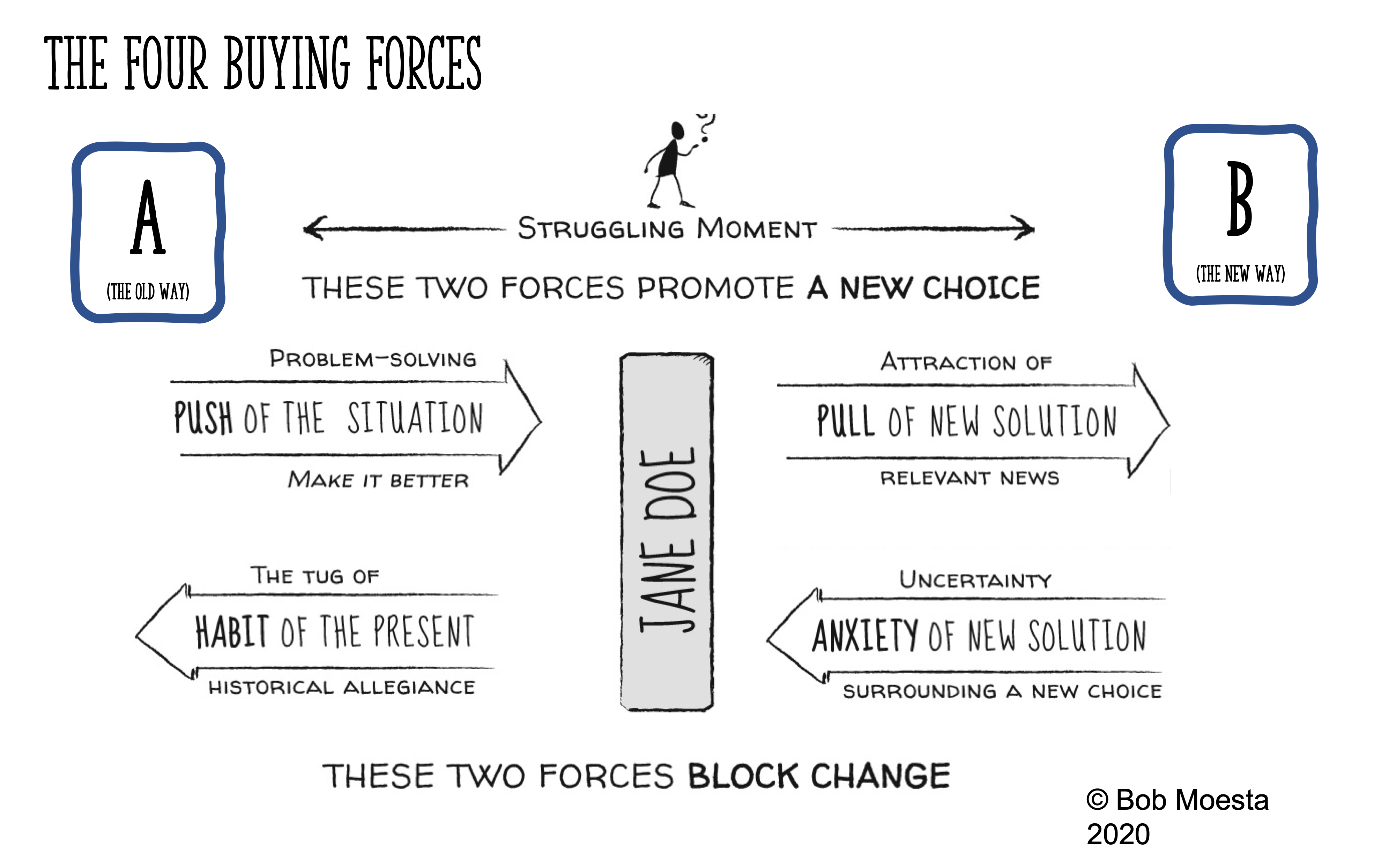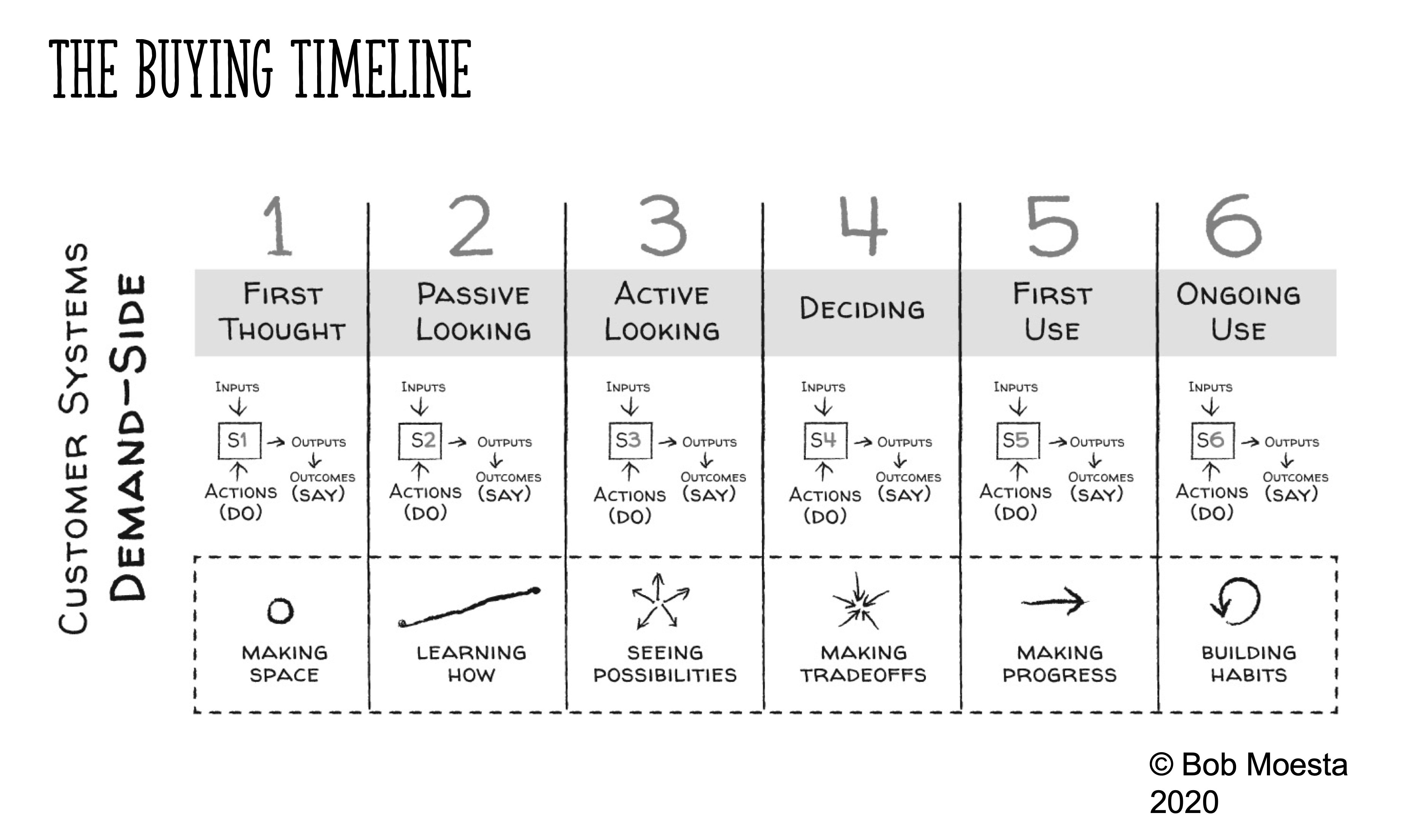I hadn’t heard of Bob Moesta’s work until Mark Littlewood, CEO of The Business of Software, recommended I watch a couple of videos from last year's UK conference.
I knew of Bob’s long-time collaborator and mentor, Clayton Christiansen, author of “The Innovators Dilemma” and numerous other publications, and his famous quip about why people buy a ¼” drill. They don’t buy it because they need the drill, they buy it because they need a ¼” hole somewhere.
Bob and Clay created a seminal theory about why people buy any material good or service that is considered a purchase, called “Jobs to be Done.”
The theory states that people hire products to make progress in their lives and to get the outcomes they seek. This theory is important for sales and marketing professionals to learn and consider in their go-to customer approach. Buyers don’t care about your product features and benefits, they care about overcoming problems, making progress, and getting things done at work, at home, and at play.
Bob Moesta is an engineer, innovator, author, thinker, and entrepreneur. In his career, he has helped thousands of people launch more than 3,500 products, everything from candy bars to household detergent to motor vehicles and SaaS software.
Bob Moesta’s book Demand Side Sales-101 extends “Jobs-to-be-done” thinking into an easy-to-apply framework for sellers and marketers to understand where customers are in their timelines and what they are up against when making buying decisions. Warning: Reading it is like taking the red pill in the movie The Martix. You can’t go back once you have read it.
 Bob has had considerable exposure to traditional technology marketers and “Supply-side” thinking that obfuscates a product’s functional, social, and emotional value to consumers. Supply-side thinking comes with personas, demographics, and psychographics as well as the company-branded strapline, value prop, product features, and benefits, all content that marketers and salespeople package and spray liberally at “ideal customer” targets.
Bob has had considerable exposure to traditional technology marketers and “Supply-side” thinking that obfuscates a product’s functional, social, and emotional value to consumers. Supply-side thinking comes with personas, demographics, and psychographics as well as the company-branded strapline, value prop, product features, and benefits, all content that marketers and salespeople package and spray liberally at “ideal customer” targets.
Whereas “Demand-side” thinking attempts to understand a buyer’s context and how, when, where, and why, they might hire a product to make progress.
When marketers and salespeople understand where buyers are in their timeline to change and the opposing four forces that accompany every decision to change, more meaningful communication becomes possible.
The Four Forces Model
The Four Forces Model conceptualizes the two forces that push a decision forward; the struggling moment, and the pull of the new, and the two forces that block; the habit of the present, and the anxiety of the new. When marketers and salespeople understand these fundamental forces they can communicate and connect with buyers in ways that create new possibilities.

“Marketing’s job is helping to prepare people to change” – this is a phrase from Bob’s talk about the book and it’s a profoundly different way of thinking about marketing communication.
Here's a simple test you can run on your website to see how well your core marketing messaging is aligned with helping your buyers overcome their struggling moments and the outcomes they seek. Add the words, "Now you can"... If your website is all about the product and not the outcome your buyers want, it's a clunk. For example, applying this to my Website, you get, With Why Change Selling, Now you can Design and Master Critical Sales Conversations to Improve Engagement, Build Pipeline, and Boost Win-rates.
The Buyers Timeline
The Buyer’s Timeline is another interesting perspective on the buying process. Bob makes important points about when and how to demo products as the buyer advances from first thought to first use, as the context of the demo and viewing audience change.

Making Progress in Your Sales Career
Selling is hard and seemingly gets more complex every year. That’s why salespeople must adopt a lifelong learning philosophy to stay current and relevant in a world where salespeople who create no value are disintermediated from the process.
The future of selling as a profession is consultative, and the required skillsets to compete in the arena are increasing in breadth and depth every year.
Bob Moesta’s book helped me look beyond the surface structures that buyers present and dig for their how and the why—the causation. It helped me understand the social, emotional, and functional jobs they are trying to get done that are causing them to want to speak with me. It also helped me understand the events that drive the purchase process, where they are in their timeline, and the blockers that cause deals to end in no decision.
Bob reminded me that the most important skills to master in selling (and life) are language and communication, and to listen intently to the language buyers use when they open their conversation to truly understand where they are coming from, their struggling moments, and the impact it has on them and those around them.
I strongly recommend reading Bob Moesta’s book, Demand Side Sales 101, and then reading Bob’s next book, Learning to Build… in that order.